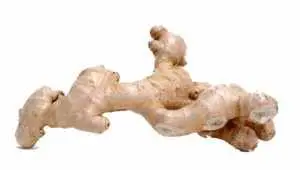Share on Social Media:
The Top 5 Ginger Producing Countries
| Country | Ginger Production 2011 (metric tonnes) |
% of World Total | |
|---|---|---|---|
| 1 | India | 702,000 metric tonnes | 34.6% |
| 2 | China | 388,886 metric tonnes | 19.1% |
| 3 | Nepal | 216,289 metric tonnes | 10.6% |
| 4 | Nigeria | 160,000 metric tonnes | 7.8% |
| 5 | Thailand | 152,630 metric tonnes | 7.5% |
 Special Report
Special Report
- Ginger is a tropical species native to South East Asia and is the underground stem (rhizome) of a perennial herb, which is used as a spice and as a preserve. The English term 'ginger' originated from Sanskrit word 'Sringavera.' Botanically known as 'Zingiber Officinale,' it is the most popular hot spice in the world. The useful part of this plant is the underground rhizome. The knobby rhizome is dug up when the 1 meter tall leaves and stems of the plant wither, which occurs between 6 and 12 months after planting. It is then prepared for market by either scalding it to produce black ginger, or by scraping and washing it to produce white ginger. It is sold in the fresh state or, more frequently, in a peeled and split dried form. Ginger is utilized widely as a spice, for pickles, candies and as a medicinal herb. It can be produced in many countries but it does best in moist, tropical conditions. Cochin Ginger (NUGC) and Calicut Ginger (NUBK) are the two popular varieties of Indian ginger in the world market. Out of the total production, about 30 per cent is converted into dry ginger, while 50 per cent is consumed as green ginger and the rest as seed materials. Dry ginger is produced mainly in Kerala, a major share of which is exported.
- World production for ginger in 2009 was 1,618,627 metric tonnes. Ginger is cultivated in India, China, Japan, Indonesia, Australia, Nigeria and West Indies islands. India is the largest producer and consumer of ginger in the world. Indian ginger is produced in the states of Orissa, Kerala, Karnataka, Arunachal Pradesh, West Bengal, Sikkim and Madhya Pradesh. Kerala is the largest ginger producing state, accounting for about 33 per cent of the total production in India.
- World trade in ginger is estimated at $190 million per year. The largest ginger importers are the United Kingdom, the United States and Saudi Arabia. Ginger production in Nepal During 2008 - 2009, increased to 178,988 tons of ginger and exported ginger worth Rs 1.37 billion ($18,3 million US dollars) - about 99 percent of total production to India. Nepal imported ginger worth Rs 550 million ($7,74 million USD) during the same period however.
- Ginger has been used for its health benefits for over 5000 years and is used in Asian medicine to treat stomach aches, nausea, and diarrhoea. Many digestive, anti-nausea, and cold and flu dietary supplements sold in the United States contain ginger extract as an ingredient. Ginger has been used used to alleviate post-surgery nausea as well as nausea caused by motion, chemotherapy, and pregnancy. Ginger also has been used for rheumatoid arthritis, osteoarthritis, and joint and muscle pain.
- Studies suggest that the short-term use of ginger can safely relieve pregnancy-related nausea and vomiting. Studies are mixed however on whether ginger is effective for nausea caused by motion, chemotherapy, or surgery. According to the U.S. Department of Health and Human Services, it is unclear whether ginger is effective in treating rheumatoid arthritis, osteoarthritis, or joint and muscle pain. NCCAM-funded investigators have looked at whether ginger interacts with drugs, such as those used to suppress the immune system, and ginger's effects on reducing nausea and vomiting.
- Food and Agriculture Organization of the United Nations.
- Dr A.T.N. Abubacker: "Export Potential of Ginger" April 2009. Department of Economics, Dr Zakir Husain College, Ileyangudi, Tamil Nadu, India.
- U.S. Department of Health and Human Services Fact Sheet "Herbs at a Glance", May 2006.
- Ghirime, Prabhakar. "Nepal 4th largest ginger producer in the world" Myrepublica.com. 21 October 2010. Web. 22 October 2010.
Tags:
Crops
Sources: FAOSTAT data, 2014 (last accessed by Top 5 of Anything: January 2014).
List Notes: Ginger production is in metric tonnes (m/t) for the year 2011 (latest year for which statistics are available as of Jan 15th, 2014). This top 5 list may include official, semi-official or estimated data gathered by the Food and Agriculture Organization of the United Nations.
Sources: FAOSTAT data, 2014 (last accessed by Top 5 of Anything: January 2014).
List Notes: Ginger production is in metric tonnes (m/t) for the year 2011 (latest year for which statistics are available as of Jan 15th, 2014). This top 5 list may include official, semi-official or estimated data gathered by the Food and Agriculture Organization of the United Nations.

